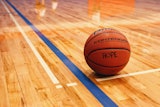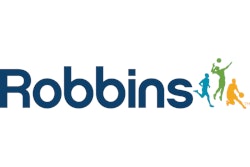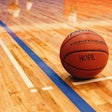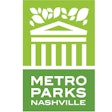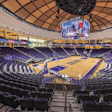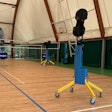Explore 250+ Exhibitors and 190 Educational Sessions at AB Show.
Visit abshow.com for more information.
The Road to the Final Four is paved in maple. And so are the majority of gymnasiums at every level of competition across North America. For every 100 gyms that feature a hardwood court surface, an estimated 95 are constructed of maple — northern hard maple, to be exact — and most of those have been specified to be second-and-better-grade maple (more on that later).
So what's left to think about when selecting a hardwood gym floor? Plenty — including these 10 questions.
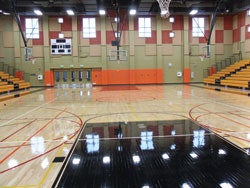 The best time to apply all court markings is prior to a gym floor's finishing process. (Photo courtesy of Maple Flooring Manufacturers Association)
The best time to apply all court markings is prior to a gym floor's finishing process. (Photo courtesy of Maple Flooring Manufacturers Association)1. What activity is going to take place on the floor?
Consider more than just the sports activity (what's good for basketball in terms of such factors as shock absorption and coefficient of surface friction is also good for volleyball). Think about whether bleachers and portable backstops will have to be rolled across the floor and locked into position. Perhaps a scissor lift will be needed to maintain light fixtures. "We've even had gymnasiums where people occasionally drive trucks or some other large rolling vehicle that has to be brought into the gym," says John Ficks, marketing manager at Robbins Sports Surfaces. "We need to make sure it can withstand those rolling load weights."
This typically influences the choice of subfloor system most, and may require that the chosen subfloor be fortified with solid-block construction in those areas where rolling loads come to rest. It can also mean specifying an alternative surfacing product, such as edge-grain parquet maple, which is more resilient to point and rolling-load damage than traditional strip maple, Ficks says.
Field houses that host track and field events in addition to basketball and volleyball need not abandon hardwood entirely, as synthetic tracks can surround hardwood courts. "We're seeing a lot of dual construction, where it will be basically a true full subfloor system underneath the synthetic system, as well as underneath the hardwood system, so everything is that one monolithic height all the way across," says Ron Fenhaus, sales director at Action Floor Systems LLC. "It gives the synthetic floor a substantially better feel versus just being on the concrete."
2. Which subfloor system best suits the application?
The traditional floating floor, with evenly spaced ¾-inch-thick rubber pads separating the substrate from two ½-inch layers of stapled plywood, to which strips of maple are then nailed, is still an economical and entirely functional choice. However, anchored-resilient systems (also referred to as fixed-resilient or fixed-floating floors) are gaining in popularity. According to the Maple Flooring Manufacturers Association, in 2003 these systems were found in 17 percent of athletic settings with maple flooring (including gyms, squash and racquetball courts, and group exercise rooms). In 2010, they were found in 23 percent of such spaces. While traditional floating floors owned 55 percent of the athletic market in 2006, they garnered a 49 percent share in 2010.
There are dozens of subfloor options, with flooring providers offering true proprietary innovation with some products, as well as mere tweaks of systems that are offered by more than one company. Today's technologies may incorporate steel and synthetic materials into systems that employ pins, channels or clips. They also come in different profile heights, an important consideration in renovation scenarios, according to MFMA executive director Dan Heney. "There are low-profile systems and high-profile systems," he says. "If you have to meet existing entryways, you may be limited in the type of systems that you can specify for that floor replacement based on the concrete depression."
When selecting a subfloor system, due diligence by the facility's ownership is a must. "You need to understand what you're buying," says Doug Grove, national sales manager for Connor Sports Flooring. "There are enough systems out there that you just can't casually look and see two or three and understand. You have to invest some time in getting to know what the different subfloor configurations are and what benefit they provide."
3. What type of environment will exist inside the gym?
Is it controlled by an HVAC system? (Some gyms aren't, believe it or not.) Is it located below grade or near a natatorium? Is it in a region of the country that sees substantial seasonal or even daily swings in relative humidity? In other words, how much moisture — hardwood's nemesis — will the floor potentially encounter?
Maple will expand as it takes in moisture and contract as it dries out, particularly at the outset of the floor's lifecycle. It must be installed to account for these changes, typically by allowing 18 -inch expansion gaps every two feet or so between tongue-and-groove boards, or smaller voids on either side of each board. Likewise, the subfloor must be designed to allow the maple to adjust to varying conditions in the gym, and this is where anchored-resilient systems outperform floating floors. Since the latter's components are essentially fully integrated (nailed together), pads may actually be pulled off the substrate as the floor adjusts, creating dead spots under the feet of dribbling basketball players. According to Steve Chase, general manager of Fitness Flooring, which offers gym floors made of clipped-together strips of beech over a foam underlayment, ball response can quickly become a top priority among end-users. "If the ball doesn't come back up where there are dead spots, people are going to go, 'Yeah, we don't care so much about resilience,'" he says.
In new construction, the building architect is expected to provide MFMA-approved conditions for a wood floor, Grove says, adding, "On a retrofit, we would have to look at existing conditions and, most important, the flatness of the substrate and the vapor emissions in the substrate. If you're tearing out one wood floor, and you had moisture problems, why did you have moisture problems? Was the moisture coming through the slab? Was it coming down a wall?"
4. How important is the broader environmental consideration: sustainability?
 Wood floor aesthetics can vary from the monochromatic look of second-and-better maple, as seen on this basketball court, to the rustic character of the surrounding third-grade strips. (Photo courtesy of Maple Flooring Manufacturers Association)
Wood floor aesthetics can vary from the monochromatic look of second-and-better maple, as seen on this basketball court, to the rustic character of the surrounding third-grade strips. (Photo courtesy of Maple Flooring Manufacturers Association)Sustainably harvested hardwood and plywood is available, as are subfloor systems made entirely of post-consumer recycled materials. "Are there any LEED requirements that you're going to want to have fulfilled in the process of installing the gym floor?" asks Ficks. "If so, all of that information needs to be brought to the attention of the gym floor contractor up front to make sure the requirements of LEED are going to be met."
"Often, they just want to use a sustainable product," Grove says. "A lot of people don't want to pay for LEED certification, but they still want to make good environmental choices. That really became clear to us within the last couple of years."
Twenty years ago, a facility owner might have questioned the performance of recycled materials, adds Grove. Not anymore. "The Boston Celtics have played on a recycled pad for 12 years," he says. "And that's one where they're taking the floor up and putting it back down, so if they had an issue with the pad, they'd see it."
5. What grade of maple should be specified for the playing surface?
Grading was once a concern mainly because of board-length irregularities that may occur at the bottom end of the grading scale, but today's subfloor systems have made that a moot point. Now, manufacturers agree, it's solely an aesthetic consideration — at one end of the spectrum is first-grade maple (with its clean, monochromatic appearance); at the other, third-grade maple (with its occasional pin knots and mineral staining). In between is second-and-better grade, and Ficks estimates that between 70 and 75 percent of all gym floors are specified on this middle ground.
While everything from elementary school gyms to NBA arenas have been specified with first-grade maple, many end-users prefer the rustic character (and slightly lower cost, potentially) of third-grade, which Grove insists will perform every bit as well over the life of the floor. "When manufacturers mill maple, we don't mill third-grade. We mill the boards and pull the third-grade out," he says. "So it just happens that the mills in general have 60 to 70 percent that are second-and-better, and then 15 to 20 that are first or third. So just by the nature of the product, you're going to sell more second-and-better floors."
6. What type of finish should be specified?
Depending on where the facility is located, there may not be a choice. VOC regulations in some parts of the country, most notably California, essentially prohibit the use of oil-based finishes. And while they emit no VOCs, waterbased finishes carry their own concerns. When applied to a floor that experiences cycles of expansion and contraction, waterbased finishes may cause a condition known as panelization - essentially the gluing together of maple strips to the point they are rendered incapable of self-adjustment. "As the floors release moisture and contract in the fall and the winter, the floor can't move," Ficks says. "It's locked in place and essentially finds the weakest point in the floor, and you just end up with significant gaps like lightning bolts through the floor that can mean an unusable gym floor in some cases."
"Sometimes that bond is so strong that it can literally rip a maple board in half," adds Heney, noting that to be endorsed by the MFMA, a finish must undergo third-party testing at least once every three years. "Panelization was a big, big problem 10 to 15 years ago. The MFMA does 15 to 20 floor inspections a year, and in the past, I would say 14 to 18 of them were prompted by panelization. Now, we see maybe one or two a year that deal with panelization. It still does happen."
Moreover, it's less of a problem after the first couple of waterbased finish applications, once the floor has had a chance to acclimate to environmental conditions and stabilize.
Hue and gloss are two factors that may weigh into a finish choice, as well. Oil-based finishes tend to amber over time, providing that rich gym floor appearance that many onlookers expect, while waterbased finishes are for the most part clean and clear.
Gloss caught the national sports media spotlight in 2011 when the University of Oregon debuted a home court painted to depict a stand of evergreen trees. The floor proved so shiny that reflections created by the arena's ribbon boards distracted the television viewing audience. Bill Price, national sport manager for finish manufacturer Bona US, which handled the Oregon project, says the floor graphics were originally supposed to be depicted not with paint, but rather stain, which would have toned down the glare significantly. However, staining maple (a difficult task, but an emerging trend nonetheless, according to Price) would have required twice the manpower hours.
"One of the biggest complaints that we get from NBA teams and from a lot of Division I schools is that because of the lighting, the ribbon boards and the scoreboards that are right on the floor, high glare can be very distracting," says Price, who has been working with NBA teams on a lower-sheen product. "The roadblock is coefficient of friction. When you take a gloss product and try to flatten it, the additives that are used to bring the shine down contain silicate, a form of silicone, and they definitely make those floors slipperier than they should be."
He remains confident that a suitable formulation is forthcoming. "Once one or two NBA floors go semi-gloss or go even to a satin sheen," Price says, "that trend will probably kick in relatively quickly and trickle down."
7. Should game lines and graphics be determined up front?
 Painted designs and high-gloss finish on the University of Oregon's new competition court prompted viewer complaints, but flatter finish formulations are in the works. (Photo by Eric Maxwell/AECOM)
Painted designs and high-gloss finish on the University of Oregon's new competition court prompted viewer complaints, but flatter finish formulations are in the works. (Photo by Eric Maxwell/AECOM)Yes, and it goes back to the first question, this time in a strictly sporting sense, of predetermining all potential uses for the floor. The best time to apply game lines is upon floor installation. If a gym is going to serve basketball and volleyball, mark it accordingly and be done with it, so that a protective coat of finish can be applied over the painted game lines. Taping, for example, a volleyball court's dimensions to the floor after the fact is not recommended, since tape will likely have a different coefficient of friction than the floor's finish (posing a safety risk to participants), and removal of the tape can result in finish coming off with it.
Temporary decals made news in November when a Michigan State basketball player slipped on a title sponsor logo during the Quicken Loans Carrier Classic, drawing the ire of the game's opposing coaches and basketball pundits alike — and that was before a University of Memphis player likewise injured himself on an EA Sports/Maui Invitational sticker less than a week later. "They could be more slippery or more grabby," the MFMA's Heney says of decals. "We don't recommend that you use them."
8. What can be expected in terms of maintenance?
If facility owners aren't willing to do the minimum necessary to protect their investment in a hardwood gym floor, they should probably not purchase one. "You have to be prepared to take steps to maintain it properly," says Ficks, who recommends a daily dust-mopping and regular cleaning with a solution recommended by the finish manufacturer. Beyond that, the floor should be screened and recoated once a year, and sanded down to bare wood, resealed, repainted and refinished every 10 to 15 years. "The reality is, most schools' maintenance budgets right now are not allowing that to happen, and you see a lot of floors that are 20, 25 years old that have never been sanded down to bare wood," Ficks says. "It generally shows. The floor gets darker. The game-line colors are not as bright as they should be. If you do take that step to sand and finish that floor every 10 to 15 years, at least from an aesthetic standpoint, you're essentially getting a brand-new floor."
9. Who should be trusted to install the floor?
About four years ago, the MFMA developed an accreditation program targeting individuals on the job site. "Not necessarily the owner of an installation company," Heney says, "but actually what I call the mechanic — the guy who goes out there and actually nails that floor in."
MFMA-accredited installers are tested every two years by the association, as well as flooring manufacturers, to ensure that the installation recommendations of both are being followed. "Basically, it's a continuing education program," says Heney. "An architect can write into his or her specifications that the installation company should be an MFMA-accredited company. And he or she can also write in that MFMA-accredited installers should be onsite during installation. Then you know you have an experienced, knowledgeable installer in there actually putting in your gym floor."
10. Can the performance of the completed package be assured?
Facility owners leery of wading through the alphabet soup of flooring standards and guidelines — from DIN to EN to ASTM — can now turn to the MFMA's Performance & Uniformity Rating, or PUR standards. Released in November 2009, the standards represent an amalgam of the others, addressing five familiar performance characteristics — shock absorption, vertical deflection, area of deflection, basketball rebound and surface friction. "The biggest difference is that the PUR standards are not only about performance, but also uniformity," Heney says. "It's what really sets our standards apart."
According to Heney, a floor that passes the DIN standard, even with significant outliers in testing results, wouldn't necessarily meet PUR standards. Ficks, for one, has embraced the new standards, which when met allow a flooring installation to be stamped with the MFMA PUR seal of approval. "In the United States, there is no governing body for sports floor performance that dictates that the floor should have certain performance and safety characteristics," he says. "The PUR standards create a very level playing field and really demand a very high level of performance from an athletic floor."
Adds Heney, "All the standards are produced by countries outside of North America and involve several synthetic surfaces, whereas our manufacturers, while they produce synthetic floors also, focus this standard on a wood floor and a wood floor only."
For many facility owners, only a wood floor will do, and none of the above considerations should change that mindset. They should only serve to help ensure that owners, and ultimately end-users, fully realize all the benefits that hardwood gym floors have to offer, and that those benefits endure for as long as possible.
Fenhaus points out that hardwood floors have been specified in gymnasiums nationwide for more than a century. "Wood floors have been installed in facilities that never had air conditioning, and those floors are still there," Fenhaus says. "You're making an investment. If you're expecting a facility to have a 60-year lifecycle, shouldn't you expect the floor system to meet that same lifecycle? If you take care of a maple floor, take care of the building so the floor doesn't suffer water damage, that floor will meet those lifecycles."














